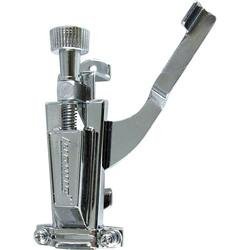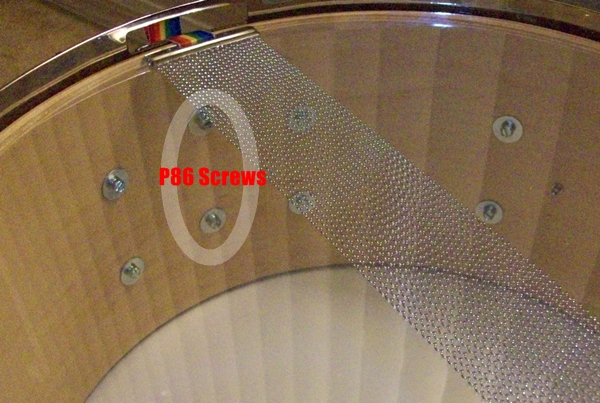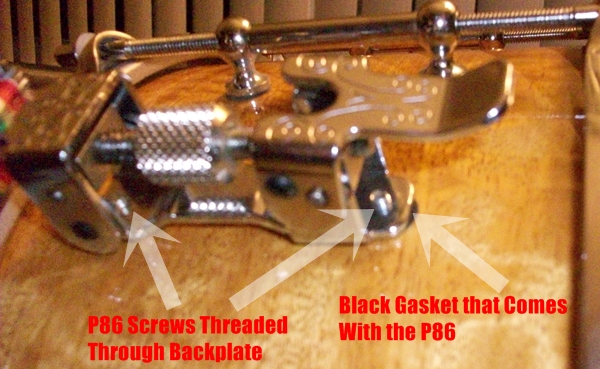One interesting thing is Amazon now sells on-demand video rentals, some of which are music-related, so I have included a few in the new blog. Do check it out.
Friday, February 19, 2010
Old Drums For Sale Blog Refactored
Thursday, February 18, 2010
Upgrading your Ludwig Snare Drum to a P86

My reasons for disliking it stem from the fact that it sticks when trying to reengage snares, often requiring that you not only use the lever, but also simultaneoously pull up on the adjustment knob. The P85, like the P83 before it, and the modern P86 all have the same hole pattern. Therefore, the P86 will fit WFL and Ludwig Pioneer snare drums, Acrolites, Classic Maple, and Supraphonics. It will not fit the new Black Magics, the Epic-series, and possibly Rockers and Accent snare drums (I haven't tried the latter, but have heard they will not fit the hole pattern.) I do know for a fact that the P86 will not retrofit to a Black Magic, much to my chagrin.
Here is what the P86 looks like:
If you want to see how one looks, check these links to my snare drums that either came with the P86, or which I upgraded:
There are more on this site, but you get the picture.
One mistake many people make when doing the upgrade is to try using the screws that originally came with the P85, often installing them from the outside of the shell in and using nuts, or leaving out the black washers that come with the new P86. The following photos of my Ludwig Special Edition Satinwood snare drum show the correct way to install it and where the components in the bag go.
What comes in the bag

Inside shot of a wood shell showing the P86 screws

Outside shot of same shell showing where the screws go through the tapped holes in the backplate and a little of the black gasket peeking out (this is a stock Ludwig snare drum)

A close-up of the P86 (note the threads of the screws and a little better shot of the gasket at the right end.)

I hope this clarifies the correct way to install a P-86 for you. Life is too short to struggle with a P-85!
Woodshedding!
Stones's Accents and Rebounds: For the Snare Drummer is the logical next resource to use after you have mastered (or at least are comfortable with) the lessons in Stick Control.
Joe Morello, teamed with one of his star students, created a series of DVDs that will instill a relaxed, natural technique that is founded upon connecting the dots between how your body works and how you communicate with the drums via sticks. In some ways I feel that this series (or at least lessons 1 & 2) should precede Mr. Stone's workbooks. What holds me back from recommending that particular lesson is the videos are somewhat unfocused (too much banter and anecdotes between Joe and Danny Gottlieb), and I feel that anyone who has not tackled Stick Control should proceed post haste into the lessons. Don't take this as my diminishing the lessons embodied in the "Natural Approach to Technique" because they are important. Perhaps interspersing Stone's workbooks with Morello's videos is a good compromise. Here are the videos:
- Mel Bay's Natural Drumming: Lessons 1 & 2
- Mel Bay's Natural Drumming Lessos 3&4
- Natural Drumming: Lessons 5 & 6
An alternative set of lessons on natural technique that Joe Morello did are these two videos:
- Joe Morello: Drum Method 1--The Natural Approach to Technique
- Joe Morello: Drum Method 2 -- Around the Kit
Of the two, I recommend the first set, and you can easily make do with just the first one (Mel Bay's Natural Drumming: Lessons 1 & 2).
Regardless of which of the above you opt for, I strongly recommend Master Studies (Percussion) as the next step in your evolution as a drummer after Stone's two books. And, of course, the next step after that is Master Studies II: More Exercises for the Development of Control and Technique
If you manage to work through the preceding books (and videos) - a daunting task to be sure - you can tap into the late, great Jim Chapin's lessons in Jim Chapin -- Speed, Power, Control, Endurance (DVD). Mr. Chapin is one of the true greats who influenced generations of drummers, and his body of work will continue to do so. Needless to say, Advanced Techniques For The Modern Drummer: Coordinating Independence As Applied To Jazz and Be-bop With Cd
logically follows. Also valuable: Music Minus One Drums: Modern Jazz Drumming
One final recommended lesson DVD for the dedicated, woodshedding drummer is John Riley: The Master Drummer - How to Practice, Play and Think Like a Pro (DVD). Again, read the Amazon reviews which are effusive in their praise for this DVD.
... Don't forget: you will need a metronome! I like the Korg MA-30 Ultra Compact Digital Metronome. Also, for anytime, anywhere practicing check out the Vic Firth Double sided, 12" Practice Pad
, or, even better, Rhythm Tech Lap Top Practice Snare Drum 1
.
Finally, enjoy some of Joe Morello's wizardry:
My Favorite Instructional Videos: Grooves
On Groove Essentials 2.0 the instruction is much faster paced than 1.0, and assumes you have mastered 1.0.
The theme of 2.0, aside from odd time signatures, differs from 1.0 in that in the first DVD you were taught the "connective tissue" of keeping a groove - anchoring on a cymbal pattern or, perhaps, a bass drum to form the foundation of the groove. In 2.0 the theme is constructing a groove and the focus is on groove types covering rock, funk, jazz and world.
The highpoint for me was the lesson on brushes. These were all so briefly touched upon in the original DVD, but were expanded in two lessons on the second. You won't become a brushmaster, but if you are new to brushes the two lessons will propel you. Here are a few clips from 2.0 that showcase Tommy Igoe's talents as both an exceptional drummer and instructor:
I strongly suggest that you augment the DVDs with the following books/DVDs that are companions to the DVDs:
- Groove Essentials - The Play-Along : A Complete Groove Encyclopedia for the 21st Century Drummer
- Tommy Igoe Groove Essentials 2.0 - The Play-Along Book/CD
Tommy will be filming Groove Essentials 3.0 in the Fall of 2010, but is mum about the subject matter. I can assure you I will be ordering it as soon as it's published.
One final Tommy Igoe resource is his Tommy Igoe Great Hands for a Lifetime, which was recently published. Here is the trailer:
More on Calfskin Heads
The best source of calf heads, though, is Stern Tanning, which is the gold standard in calf heads. Rob also authored Absolute Authenticity: When Only Cowhide Counts for Drum! Magazine that I recommend reading if you have any interest in natural heads.
A less expensive choice for natural heads (albeit goat skin) is Earthtone. Yes, they are goatskin heads instead of calf, but they are a compromise between cost and tone. I have little experience with Earthtone heads, so proceed at your own risk. There are many happy customers, but the diehard calfskin folks claim that there is a world of difference between the two.
In the close, but no cigar category, there is always Remo's Fiberskyn. I prefer the Fiberskyn 3 Diplomat Thin Weight Drum Heads, but there are others who prefer the Remo FiberSkyn 3 Medium Batter Head
weight. I pair mine with Remo Renaissance Ambassador Tom Batter heads
for resonant side heads (yes, I know the product description calls them batter heads, but they do go very well with the Fiberskyns. Another head that I like is the Remo Skyntone Drumhead, 14 inch
, which comes in only 13" and 14" (although I have heard a rumor that Remo will shortly be releasing this model in all popular sizes.) Do be aware that these heads are thin and may not lead long lives if you are a heavy hitter. For brushes, shuffles and press rolls, however, they are excellent.
Wednesday, February 17, 2010
The Zildjian Trademark

More about the Zildjian company and family history: World's Leading Cymbal Maker: Avedis Zildjian Company, which is an 11 page history of the company, and Manufacturering Secrecy: The Dueling Cymbalmakers of North America, which has another aspect of the history, including Robert Zildjian's split from the company to found Sabian.